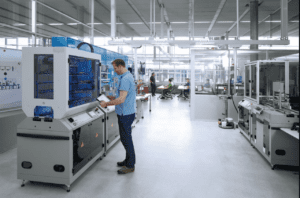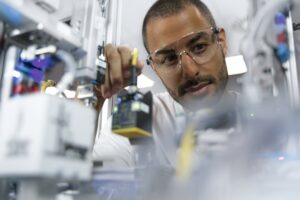Close the Skills Gap through Apprenticeships
Degree and certificate programs with paid on-the-job training are investments in a company’s future.
Posted: December 20, 2022

Fabricating and metalworking companies face a major challenge: finding qualified machinists. Today’s skills gap, which is the mismatch between the skills possessed by job seekers and the skills needed by employers to fill current and future roles, shrinks the available talent pool. Apprenticeship programs are a proven solution to close the skills gap and promote long-term retention of high-value technicians.
There are many misconceptions about apprenticeships that may dissuade companies from considering this staff-building option. One misconception, rooted in history, is the idea that apprenticeships are union based. This is not the case. Today, there are more non-union than union apprenticeship programs.
Another mistaken belief is that apprenticeships are too expensive. Yes, they do cost money and require time to manage. But so does hiring untrained workers. Consider the cost and time involved in apprenticeships as investments in the future for maintaining competitiveness.
Return on Investment
The 2022 report from the Department of Labor, Do Employers Earn Positive Return on Investments in Apprenticeship, found that: “Using the medium estimate, the typical employer experiences more than $17,800 in net benefits per apprentice, or an annualized return on investment of 6.3%.”
A 2016 study by Case Western Reserve University and the Department of Commerce, The Benefits and Costs of Apprenticeship: A Business Perspective, used case examples to better understand the effects of apprenticeships on individual companies. That study found that Siemens USA, for example, obtained at least a 50% rate of return on its apprenticeship program compared to hiring machinists off the street. Most of the gains stemmed from the way that apprenticeship allowed Siemens to flexibly fill needed capacity at its Charlotte, N.C., facility.
There are a host of state and federal funding sources available to help defray the cost of apprenticeships. In September 2022, the Department of Labor announced plans to invest more than $330 million to expand and diversify Registered Apprenticeships through grants to states, employers, labor organizations and workforce intermediaries.
Additional Misconceptions
Another misconception is that apprentices leave after they are trained. Not so. The Department of Labor – ApprenticeshipUSA reports that there is a 93% employment retention of apprentices who complete their program. The average starting salary after apprenticeship completion is $77,000 according to ApprenticeshipUSA, and the lifetime earnings differential between credentialed and non-credentialed workers is more than $300,000. All of which demonstrates that apprenticeships offer benefits that can attract top talent and provide the incentives to retain that talent.
Some employers express the concern that apprentice training may not fit the needs of the company. Even when offsite classrooms and labs are part of the program, the majority of training can be structured to take place on the employer’s shopfloor.
Case Western Reserve University studied apprenticeships at Hypertherm Associates in Hanover, N.H., a manufacturer of plasma, laser, and waterjet cutting systems. Hypertherm realized that its apprentices performed better than veteran workers. The company began using its apprenticeship program to retrain the existing workforce.
Mechatronics Apprenticeship Program in Southwestern Ohio

Festo Didactic, the training arm of global automation company Festo, was a founding member in 2016 of the Mechatronics Apprenticeship Program Partners (MAP2) in Southwestern Ohio. MAP2 was designed to become a model on which others throughout the United States could base their own programs. MAP2 aimed to improve the quality of the workforce for the local companies in the consortium of sponsors.
The initial companies comprising MAP2 in Ohio included Art Metal Group, Clippard Instruments, E-Beam, MQ Automation, Nestlé, Festo and others. This two-year apprenticeship involved one day a week for in-class learning, one day at the Didactic training center for hands-on labs, and three days a week working at a sponsor company, applying what the apprentice learned in class and lab. In-company mentors guided the apprentices at each host site. Those that successfully completed the program earned an associate’s degree in mechatronics and graduated virtually debt free.
At the five-year mark in 2021, the partner companies assessed the MAP2 program, looking for ways of making a good program better. Consortium partners desired a greater number of apprentices than the program was producing. They also thought that the per-apprentice cost needed to come down.
The leadership of MAP2 sought a consultant to bring a fresh perspective to the program. They engaged the Manhattan Strategies Group, a management and social sciences consulting firm dedicated to advancing workforce development and other initiatives.
In October 2022, MAP2 was relaunched as a competency-based apprenticeship rather than time based. In the revamped program, as soon as an apprentice masters a subject they move to the next. Based on past performance of apprentices, a majority of those in the program should earn their degree in 12 months rather than 24 months. This means the program can potentially double the number of apprentices at a lower cost per apprentice.
MAP2 is now also better aligned with the annual fall open enrollment in the state of Ohio’s TechCred program. Ohio has earmarked $17.5 million per year for businesses that pay for employees to upgrade their technology skills. Through TechCred, Ohio will reimburse up to $2,000 per employee and up to $30,000 per employer when a company pays for a current or prospective employee to earn an industry-recognized credential in technology-focused programs like MAP2.
There are important points to make about MAP2 as a case example of an apprenticeship program. MAP2 is a consortium of diverse local employers, creating a critical mass of trainees ideal for generating the numbers needed to make the lab and classroom training portion of the program practical. Banding together creates other synergies. For example, it draws community attention and enlarges the potential talent pool. Everyone likes to have a choice. Having diverse companies gives potential apprentices the option of joining the company of most interest to them.
MAP2 sought outside help. There are many organizations — consultants, state, federal, and academic — that are geared to helping with these programs. Build on their expertise by letting them help guide the company through the registration process, reporting requirements and recruitment.
Market the Company as a Top Employer
Become a company that markets itself as a model employer. Feature the apprenticeship program in social media and advertising. Host regular open houses for local schools, parents, and service organizations to demonstrate that today’s manufacturing careers are high tech, fulfilling and well paying. Market to groups underrepresented in traditional manufacturing and open a new, vibrant, and motivated talent pool.
The next generation of company leaders could almost certainly come from the apprentices of today. These people know what the company does from the ground up. They know how to learn. They are ambitious. Make a path for them to grow. Make an investment in the future by engaging in an apprenticeship program today.
Subscribe to learn the latest in manufacturing.













